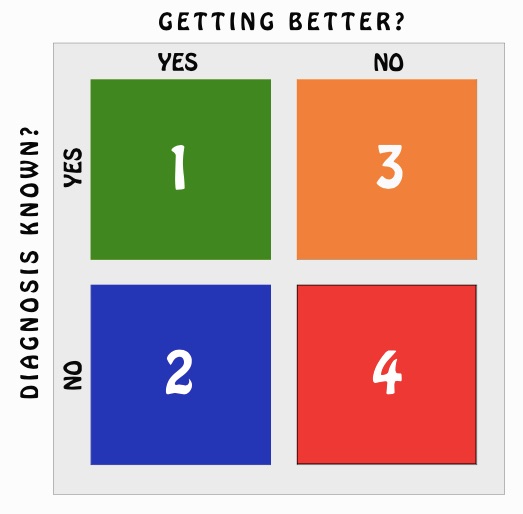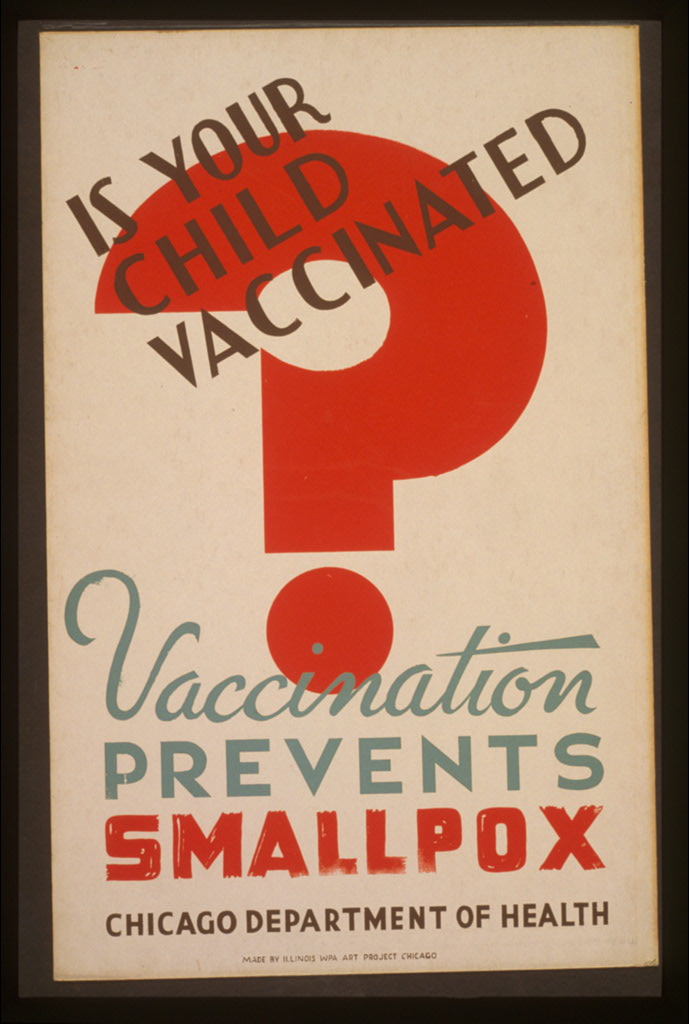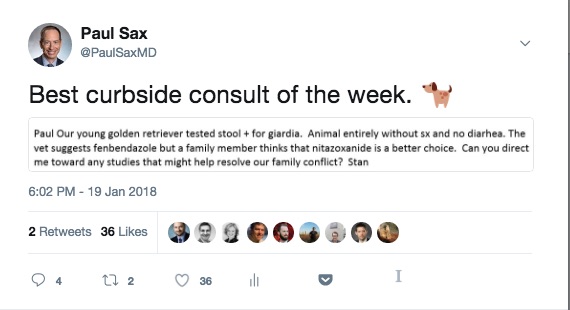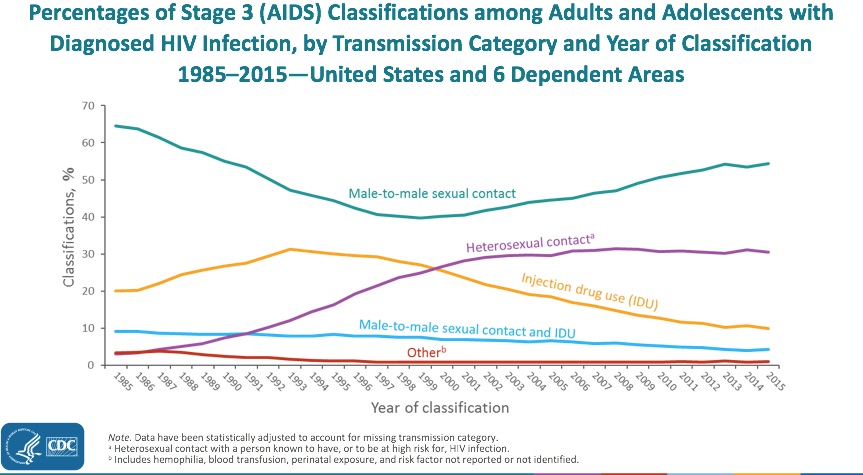An ongoing dialogue on HIV/AIDS, infectious diseases,
January 28th, 2018
Apple Wants to Build an Electronic Medical Record — Here’s Where They Should Start
If you want to get a bunch of clinicians riled up — make them really mad — ask them to describe the problems with their current electronic medical record.
So when a company like Apple announces it plans to introduce an electronic medical record of sorts, we should rejoice, right?
This is the company, after all, that leveraged the Think Different and It Just Works slogans to boast about how easy their products are to use.
However, before we can celebrate that a famous tech giant will solve the EMR quagmire, remember that this is the same battlefield that has so far flummoxed Google and, to some extent, Microsoft.
Both those tech giants have struggled to bring sense, accuracy, and usefulness to the chaos of our medical information. The million lines of code written by their software engineers may live somewhere on hard drives and servers, but they are little more than historical records of a failed enterprise.
Think the software equivalent of Napoleon’s invasion of Russia. Ouch.
Given these past lukewarm approaches (some would call them out-and-out failures), I’d recommend that Apple not be too ambitious.
Instead, they should focus on information that is simple, highly useful, and lends itself perfectly to a unified electronic medical record.
Not only that, it’s ID-related. And every clinician and patient will benefit.
Apple, please build us a Universal Immunization Record.
Here are the features of this must-have service.
- Every person would have access to their record through a user-friendly secure access. No complicated password requirements.
- Information would instantly synchronize across multiple locations, akin to what Dropbox has perfected (and has been widely adopted by other cloud systems).
- Patients would grant access to their clinicians or other vaccine stakeholders (schools, occupational health departments, immigration offices), who would be able instantly to review and to update the information.
- It will be entirely agnostic about operating system, platform, or device.
Just think how care would be transformed with a widely adopted Universal Immunization Record.
- No more ambiguity about school entry requirements or hassles about forms.
- Which pneumococcal or meningococcal vaccine has been administered? Sudden clarity.
- The problem of employee influenza vaccination tracking — solved.
- International immunization records will easily cross borders — no passport required!
- Pharmacy or health department or employer gave your patient a vaccine? No problem, now you can find it.
- Using antibody titers as a marker of prior immunization? A thing of the past — and good riddance, it’s fraught with false negatives.
- Possible vaccine repetition, “just in case”? Whether on the inpatient service, in outpatient clinics, in travel clinics, or in emergency rooms, say goodbye to this wasteful practice.
Apple, you might be tempted to add a few bells and whistles to this straightforward immunization record — say a list of medications, or allergies, or lab results, or surgical procedures, or (heaven forbid), doctor notes.
But you need to walk before you can run, so I strongly suggest you keep things as simple as possible.
Start with the vaccines. Master that first.
You could even argue that, with vaccines so globally valued (minus the anti-vaxxer fringe), that this Universal Immunization Record will be your company’s thank you gift to humankind for buying so many of your products.
A little something you can do with that nearly 1 trillion dollars you have lying around for a rainy day.
January 21st, 2018
Curbside Consults Complex and Silly, the Medicolegal Angle, and a Whole Podcast About Curbsides
Curbside consults are much on my mind this week for several reasons.
First: I received an extremely complex curbside — a case of an HIV patient (from another state) who experienced treatment failure, had developed multi-class resistance, including integrase resistance (hate that), and now faced a tricky treatment regimen.
The email was a good 300 words long and included 4 resistance reports. Phew.
But what an interesting case! The requester was, to their credit, extremely polite and grateful, which is always appreciated.
Second: Another clinician sent me a curbside that was completely the opposite — something relatively concise, and straightforward, but alas I couldn’t be of much help given the unusual patient profile.
Doubt there will be a HIPAA violation here if I share:
Third: Medscape recently reviewed the medicolegal aspects of curbside consults, an area of significant concern among ID doctors who lead the world in this activity. It’s an excellent, authoritative piece, though unfortunately the net effect could be to make one terrified of providing informal advice to our colleagues — something quite useful both to them and their patients.
Take a look at this definition of a legally safe curbside consult:
A curbside consultation refers to a consultation where the patient isn’t identified; where the specialty physician typically doesn’t review the chart, doesn’t meet with the patient, doesn’t talk to the patient, and doesn’t examine the patient; where the specialty physician doesn’t have any direct or contractual agreement with the treating physician or the hospital where the treating physician is working; where the specialist physician doesn’t bill for his services; and where the treating physician is free to accept or reject the specialty physician’s advice.
Yikes, those are a lot of criteria! Oh well.
Fourth: These general internists do a whole podcast of curbsides, on multiple medical topics — so much so that they call themselves The Curbsiders! No actual patients are discussed, of course, just imaginary ones (and no golden retrievers either).
It’s a terrific show for people in both hospital- and outpatient-based practice, and they invited me on recently to do one on ID Pearls. We covered cellulitis, Lyme, C. diff, flu vaccine, travel medicine, antibiotic allergies — in short, the very stuff we ID docs are curbsided about all the time.
Highly recommended.
Have you listened to our latest episode? ID virtuoso @PaulSaxMD takes us through a wide aria of infectious disease topics.https://t.co/58qrfTHOU0 #FOAMed #infectiousdiseases #puns pic.twitter.com/UL2cPiBiTC
— The Curbsiders (@thecurbsiders) January 16, 2018
https://platform.twitter.com/widgets.js
January 13th, 2018
Just Wondering: Antibiotics for Cough, PJP vs. PCP, TB-Sniffing Rats, Raw Water, and Other Quick ID Items to Ponder
Just think, by the end of next week, we’ll be nearly 6% done with the new year. How time flies!
For the various items below, if people know the answers, or want to speculate, have at it in the comments section.
- For patients with a nagging cough, what is the median time before they receive an antibiotic? I’m referring to actual clinical practice, also known as “the real world.” And break it down between adults and kids, please.
- And for these same treated patients, what percentage receive azithromycin? One estimate has it as 99.9621%.
- Since vancomycin plus piperacillin-tazobactam increases the risk of acute kidney injury, does this mean less empiric “Vancosyn” in acute care hospitals? Anecdotally, I think it’s having an effect at our hospital — time will tell.
- When will PJP replace PCP as the preferred abbreviation for Pneumocystis jirovecii pneumonia? More and more residents and fellows seem to be using the former, so that day will come soon. Sorry old-timers!
- In low TB prevalence regions, what percentage of patients admitted to the hospital with a low clinical suspicion of TB but who undergo a TB rule out “just in case” actually have TB? One estimate has it at 0.0379% (the inverse of the azithromycin estimate above … shocking coincidence). Only our careful Infection Control colleagues can say if this is worth it.
- When will improved approaches to Lyme testing be available in the clinic? Whether it’s serologic tests, or metabolic changes, or (even better), a reliable PCR or antigen test, here’s hoping this happens soon. Spoiler alert if you haven’t listened to this podcast — and what are you waiting for? — but this is my least favorite test.
- Will the new zoster vaccine be more broadly adopted than our current one? It’s more effective, more cost-effective, and will be easier to store and distribute, but vaccine acceptance is a tricky business. Factors will include ACIP guidelines, cost and insurance coverage, post-approval safety, and marketing — both to clinicians and direct to patients. Speaking of zoster…
- Why do so many patients think you can “catch” a case of shingles from someone else? Not referring to primary acquisition of VZV in a non-immune person — that of course can happen. I mean someone getting shingles (zoster) shortly after seeing another person with shingles. Patients continue to think this even after the whole difference between chicken pox and shingles is explained.
- Did anti-vaccine stupidity reach a new high with this recent Australian case? The father, who had measles as a child, stated he passed on his “natural immunity” to the disease to his children, so they didn’t need the vaccine. Yikes. (H/T to Keith Law for the link.)
- What proportion of ID doctors just say “isavuconazole” rather than the full name, “isavuconazonium”? This critical (and I mean critical) issue came up right after it’s approval, but now that it’s been out for a while, I’m thinking nearly all of us say the shorter “isavuconazole” — which isn’t so easy to say itself.
- Why can’t there be a single meningitis vaccine that includes all five serotypes? No doubt there is some immunologic reason, right? Or is it part of the great conspiracy to make meningococcal immunization guidelines as confusing as possible?
- Does oseltamivir actually work? Depends who you ask. Efficacy debates notwithstanding, we sure use a whole lot of it.
- Is there any medical reason to use the TDF versions of the elvitegravir- and rilpivirine-containing single tablet treatments for HIV? I can’t think of one; always surprises me when encountering someone who hasn’t switched.
- What’s the correct dose of daptomycin? Now for the quick answer: Nobody knows!
- Has the price of any other other oral antibiotic ever dropped as fast, and by as much, as linezolid? A year ago, two weeks of linezolid cost $3600; today it’s $150. Wow.
- How many people need to respond to a piece of academic spam — a bogus meeting invitation, or a predatory journal request for submissions — for these emails to become profitable for the senders? There has to be a number, or else this annoying stuff wouldn’t proliferate so wildly.
Per Journal of Infectious Diseases Editor-in-Chief Marty Hirsch, a short list of copycat predatory journals over the years — with my personal, all-inclusive favorite highlighted! #academicspam pic.twitter.com/4Xy7VEpDnw
— Paul Sax (@PaulSaxMD) December 31, 2017
- What’s the best way to explain to patients the difference between “TARGET NOT DETECTED” and “VIRAL RNA DETECTED BUT BELOW THE QUANTIFIABLE RANGE OF THE ASSAY”? There has to be a better way than using these words — especially since the clinical relevance is definitely below the quantifiable range of this clinician.
- Does anyone really understand why ampicillin and ceftriaxone are synergistic against enterococci when given together? The standard explanation is a combination of complete and partial inhibition of various penicillin binding proteins. Confess I still don’t quite get it, since the organism is intrinsically resistant to ceftriaxone, but maybe that’s just me.
- What explains the media fascination with the giant rats that can diagnose TB? Sure it’s interesting the first few times, but it seems we’re treated to a piece on these clever critters on a regular basis. The Guardian is particularly impressed — “Slow news day? I know, let’s run another piece on the TB-sniffing rats.”
- How long before we see a serious infection linked to “raw” water? As with the anti-vaccine movement, this pseudo-scientific effort to replace tap or standard bottled water with “off-the-grid” H2O includes a potent mix of homeopathy, paranoia, marketing, and charismatic zealots, with no political persuasion spared. Buyer beware!
Since we finished with a bit of homeopathy, here are three enjoyable debunking pieces — How to Counter the Circus of Pseudoscience and Top Ten Signs Your Detox May Be a Scam. and (coinciding marvellously with the football playoffs), Tom Brady is Trying to Kill You.
Of course these pieces typically preach to the choir, but they sure are gratifying to read.
And our fungal friend Candida makes a predictable appearance early in the second one!
January 4th, 2018
What’s Your Favorite Diagnostic Test in Infectious Diseases? Another Fantasy Draft
 If you’re wondering what to do while hunkering down during the “Bomb Cyclone,” here’s just the thing — the latest podcast on Open Forum Infectious Diseases.
If you’re wondering what to do while hunkering down during the “Bomb Cyclone,” here’s just the thing — the latest podcast on Open Forum Infectious Diseases.
(Remember — that’s “O-F-I-D”, not “Oh-FID”.)
Again, I welcome my friend and colleague Rebeca Plank, and this time we’re picking our Favorite Diagnostic Tests in ID.
While winter storm Grayson gives us blizzard conditions and zero visibility outside, inside you’ll sip hot cocoa, pull the blanket around your shoulders, and thrill to our selections.
We choose our top 3 favorite tests, our least favorite test, and something we wish we had in clinical practice now that we lack.
Please listen! And let me know:
- Your favorite and least favorite ID diagnostic tests.
- What should we draft next?
Meanwhile, here’s someone who knows what to do today.
https://twitter.com/CUTEFUNNYANIMAL/status/948170043350769664
December 24th, 2017
On-Service Digest, December 2017 — Plus a Holiday Song
You youngsters out there might not believe this, but there was a time when passing out copies of published papers — actual hard-copies — was a major part of the teaching hospital experience.
Now that this tree-destroying practice is over, many still regularly cite published studies on rounds. The goal is to provide some guidance and reason to clinical practice — that has to be better than the less rigorous approach of applying anecdote to an amorphous blob of clinical data.
In other words, taking care of patients is hard, and never more so than when seeing ID consults. After all, no one ever consults ID when the diagnosis is clear, the treatment straightforward, and the patient improving.
Remember that at your next salary negotiation!
Here, then, are a bunch of studies that came up in the past few weeks while seeing consults with an outstanding first-year ID fellow — who is now happily away on holiday, and hence might even have the time to read them!
- Penicillin reduces the risk of recurrent cellulitis. In many ways this is an ideal clinical trial. It takes a highly relevant clinical question — should patients with recurrent cellulitis take daily penicillin? — and then answers it in a double-blind, randomized study. The results showed that the penicillin treatment group had nearly a two-fold reduction in the risk of subsequent cellulitis, with no major drug toxicity. This is a particularly useful strategy for patients with recurrent cellulitis due to lymphedema, venous insufficiency, or obesity, infections which are mostly caused by beta strep.
- The optimal duration of therapy for gram-negative bacteremia remains unclear. Amazing how many ID consults focus on this how long should treatment continue question, and also amazing how few controlled studies answer it. So we’ll have to revert to observational studies. Here’s one paper that says 7-9 days is fine for gram negative bacteremia; but here’s another paper that says two weeks is better. Oh well, better consult the rules! And on this topic of treatment duration …
- Four days of antibiotics is just as good as eight for intraabdominal infection, with one big caveat. In contrast to the first study cited above (the penicillin one), this trial is of relatively little use to us ID doctors. And here’s the reason — it included only patients if “they had undergone an intervention to achieve source control.” In other words, these are emphatically not the sort of patients with abdominal infections who need ID consults, and the surgeons understandably rarely ask for our input. Oh well.
- Two-drug treatment with dolutegravir and rilpivirine maintains virologic suppression as well as 3-drugs. This is a particularly useful regimen for hospitalized HIV patients who develop acute renal issues, as both drugs are hepatically metabolized. Importantly, we need to check first that they’re not also receiving PPIs, which are contraindicated with rilpivirine, and that they’ve not failed treatment in the past with NNRTI resistance. And while it’s now available as a single pill, I doubt most hospital formularies are stocking this as of now. The two little separate pills will be just fine until then.
- Mycoplasma has many extra-pneumonic complications. Encephalitis, transverse myelitis, hemolytic anemia, myopericarditis, erythema multiforme, Stevens-Johnson syndrome (SJS), toxic epidermal necrolysis — you name it. Apparently, mycoplasma-related SJS has more prominent mucosal and eye involvement and frequently milder skin findings, prompting the designation of “Mycoplasma-induced rash and mucositis” or “MIRM”. Who knew?
- Oxacillin/nafcillin vs cefazolin for serious Staph aureus infections: The Debate Continues. On the one hand, there is the “cefazolin inoculum effect” of the staph beta lactamases, which theoretically could reduce cefazolin activity more than oxacillin/nafcillin in high-burden infections. Certain cases suggest this might be clinically relevant. On the other hand, there are several uncontrolled studies (here and here for example) showing that outcomes of long-term cefazolin treatment is better than oxacillin/nafcillin. Plus, cefazolin is better tolerated, and much easier to administer. Randomized clinical trial, anyone? Until then, perhaps the optimal approach is to use oxacillin initially, then switch to cefazolin once the infection is controlled.
- Primary prophylaxis for M. avium complex is still recommended in the DHHS Guidelines, but not the IAS-USA Guidelines. My take? There has never been a study of primary MAC prophylaxis in the ART era, and furthermore we want to avoid azithromycin monotherapy in someone with undiagnosed MAC, right? So count me on the IAS-USA Guidelines side. More on this issue here.
- There is still no better paper on ICU Infectious Diseases than “Fever of Too Many Origins.” I’ve covered it before, but it’s worth revisiting this outstanding perspective every so often. It brings some sanity to this challenging endeavor of seeing febrile patients in the ICU, or at least provides a group therapy session. It’s brilliant, so read it!
Happy Holidays! Please enjoy my favorite seasonal song that, in contrast to many other of the other ubiquitous holiday tunes, does not grow tiresome on repeated hearing.
December 16th, 2017
CDC Receives List of Additional Forbidden Words and Phrases
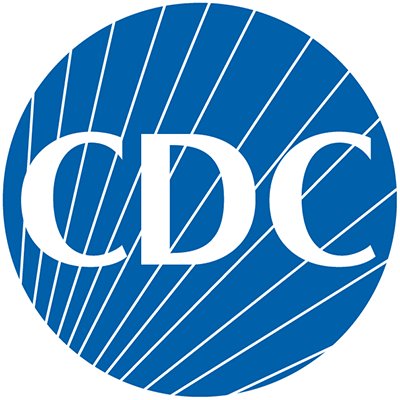 Right on the heels of prohibiting certain words or phrases in the Centers for Disease Control’s budget documents, the President’s Office of Financial Services has issued a second list.
Right on the heels of prohibiting certain words or phrases in the Centers for Disease Control’s budget documents, the President’s Office of Financial Services has issued a second list.
Now, not only must CDC officials avoid using words such as “vulnerable”, “diversity”, “fetus”, “transgender”, and “evidence-based”, they also have to steer clear of several other words or phrases.
These include the following, which were issued along with the stated rationale and, at times, proposals for alternate or cautionary language:
- “Scientific studies” — Please replace with “Dr. Oz says …”
- “Data” — Delete — it is too difficult for us to know whether this word should be singular or plural.
- “Susceptible” — We propose the following wording — “at risk due to weakness in character or upbringing or both.”
- “Funding” — We prefer the term, “market forces”.
- “Autochthonous transmission” — When cited, please include a note that it may cause blindness and/or hairy palms.
- “Transparent” — Replace with “allows light to pass through so objects can be distinctly seen.”
Certain other words — including “balanced”, “cautionary”, “inclusive”, “thoughtful”, “measured”, and “kumquat” — are also on the forbidden list, without any explanation.
CDC officials have yet to respond to these requests publically, but several have noted off the record that this is the first time they have received comments from the President’s office hand-written in crayon.
Disclaimer: In case kumquat jokes aren’t your thing, this is satire.
December 10th, 2017
Injection Drug Use-Related HIV Cases Increase in Massachusetts — Is This the Start of a Trend?
Recently the Massachusetts Department of Public Health sent out this concerning notice:
The Massachusetts Department of Public Health (MDPH) has noted an increase in newly diagnosed and acute HIV infections among persons who inject drugs (PWID). To date in calendar year 2017 (through November 21), there have been 64 HIV infections reported among individuals who inject drugs in Massachusetts … Over the past 5-10 years, newly diagnosed HIV infection in PWID amounted to 32-62 cases annually, representing a stable proportion of 4-8% of all reported HIV infections. Investigation of cases is ongoing.
Undoubtedly, one reason for the notice is that it stands in stark contrast to a long-term trend. Indeed, the drop in injection drug use-related HIV has been one of the unheralded success stories in the USA HIV epidemic.
Once a very prominent “transmission category,” it has declined more than any other risk factor, now accounting for less than 10% of new HIV diagnoses per year. For a broader view, here are AIDS cases in the USA since the beginning of the epidemic, showing the steady decline in cases attributable to injection drug use since the mid-1990s:
This decrease in cases is even more remarkable when viewed in the context of our national opioid epidemic, a problem we ID doctors are reminded of on a daily basis — not from HIV, but from serious invasive bacterial infections and, to a lesser extent, hepatitis C.
By contrast, new cases of HIV due to injection drug use alone are now relatively uncommon in the United States. A notable recent exception was the 2015 Indiana HIV outbreak, where nearly 200 new HIV infections occurred in four months in a rural community hard-hit by opioid addiction.
A skillful CDC investigation found that just one person with HIV was the source of the outbreak, which was then fueled by a needle-sharing network. The outbreak demonstrated the potential rapid spread of HIV in this population — and then the ability of syringe exchange programs to control it.
Are we seeing the beginning of something like the Indiana outbreak now in Massachusetts? Or is this year’s increase — admittedly rather small to date — just a temporary blip?
Regardless, good work by the MDPH in getting the word out — vastly preferable to be early rather than late to recognize this trend.
I’ve heard anecdotally there might be other HIV outbreaks nationally among people who inject drugs. What’s been your experience where you practice?
December 3rd, 2017
Why, Even with Depressing Predictions About Flu Vaccine Effectiveness, We Should Still Recommend and Get It

Image from “Ferrets : their management in health and disease with remarks on their legal status”, 1897.
Each year, the print and broadcast media round up a bunch of experts on influenza and ask them to predict the severity of the upcoming flu season.
Most of the time their responses are noncommittal — predicting how bad the flu season will be year to year is tricky business, akin to picking stocks, making 12-month weather forecasts in an almanac, or naming the winner of the World Series during spring training.
But this year is different. A particularly bad flu season in Australia, mostly due to H3N2 influenza A, has public health officials concerned we’re going to see the same thing here in the Northern Hemisphere.
And our flu vaccine’s estimated effectiveness against the H3N2 strain?
This low effectiveness isn’t due to a strain-vaccine mismatch. The problem appears to be related to alterations in key flu vaccine proteins during egg-based vaccine production. Or, if you prefer a more technical explanation, here’s a quote from an excellent perspective on challenges in the flu vaccine published last week in the NEJM:
Antigenic characterization using ferret reference antiserums indicates that egg-propagated vaccine viruses acquired changes in the hemagglutinin that subsequently altered antigenicity against circulating strains.
(You have to love that sentence.)
Regardless of the mechanism, even by the meager standards we hold the flu vaccine, this 10% number is a disappointment.
But this low efficacy notwithstanding, you might note that the CDC, public health officials, and the vast majority of ID doctors still strongly recommend the vaccine. They/We do so for several reasons:
- The Australia experience with H3N2 may not be recapitulated here. Although H3N2 is widespread in the USA early in the flu season, circulating flu strains change even within an individual year. In this terrific summary, read how even flu experts grapple with the vagaries and unpredictability of seasonal flu activity. And that person next to you in the subway with the cough and drippy nose may have influenza B, against which our vaccine provides much better protection.
- Even partial protection is better than none. A recent paper found that the flu vaccine prevented influenza-related hospitalizations, suggesting attenuation of severe illness. It adds to existing data supporting that the vaccine provides benefit even when it doesn’t completely prevent the illness.
- If you’re a healthcare provider, you owe it to your patients. This is especially the case if your patient population includes babies, or pregnant women, or the elderly, or people with cardiopulmonary disease, or individuals struggling with obesity, or immunocompromised hosts. Good chance this covers 100% of clinicians!
- It’s the only thing we’ve got. At least on the vaccine front, this is sad but true. There are various common-sense activities we can educate our patients about, but the adherence to these practices won’t be high.
- It’s safe. The vaccine does not cause the flu. Furthermore, the vaccine does not cause the flu. Finally, the vaccine does not cause the flu. Got it?
We doctors, nurses, PAs, and pharmacists can be forgiven if the the weak efficacy data might take some of the energy out of our annual recommendation. But let’s try to keep giving the vaccine.
And hey, you smart vaccine researchers working on that “universal” flu vaccine — we’re rooting for you!
So is the ferret.
November 26th, 2017
Should Medical Students Bring Laptops to Lectures?
 You can file this under, “Old man yells at cloud,” but here goes.
You can file this under, “Old man yells at cloud,” but here goes.
Twice a year now for over a decade, I’ve been lecturing the senior medical students in a therapeutics and pharmacology course. It’s an elective, but it’s very popular — most of the class takes it.
Not surprisingly, my topic is Treatment of HIV (duh) and my goal is to convey the “big picture” themes of HIV treatment and prevention — who gets treated and when, what we choose and why, the basics of pre- and post-exposure prophylaxis, the remaining challenges.
Since most of the students will never become ID or HIV specialists, I don’t go into much minutiae — no molecular diagrams of mechanisms of action, or complex resistance patterns, or immunology flow charts, or phylogenetic trees.
As a result, I stopped using Powerpoint years ago in this talk, instead making it as interactive as possible. I put a few key principles up on a white board as take-home points, and use cases to illustrate each one.
There’s only one problem — a few of the students never look up from their laptops, and hence don’t join in the process.
And nearly all of them now have laptops; the laptop-to-student ratio is very close to 1. It’s much greater than 1 if you count the other screens periodically appearing in the room (phones, tablets, etc).
It might be my teaching style that’s boring these laptop lovers, of course, or the topic (you could imagine that treatment of HIV isn’t high on the list of must-know items for future orthopedists), or some combination.
But there is evidence that laptops in classes and lecture halls impair learning. In this piece just published in the New York Times, the author cites several such studies:
A growing body of evidence shows that over all, college students learn less when they use computers or tablets during lectures. They also tend to earn worse grades. The research is unequivocal: Laptops distract from learning, both for users and for those around them.
It’s not just that some are checking emails, messaging friends, or engaging in whatever social media is currently vogue among their demographic. Their laptop activity is also making it harder for others in the class to concentrate, according to some studies.
Finally, the note-taking process itself is less effective at storing new material when it’s typed rather than written.
So “No laptops” is a “No brainer”, right?
Wait — it’s not quite so simple.
I’m one of those terrible-handwriting sorts for whom learning to type opened up a whole new way of communicating. I type much faster than I write, and my handwritten notes are often illegible. During our weekly case-conference, I type the details of the case into my laptop because I could never write fast enough longhand to get the details down.
I’m also the first to admit that the internet is the most extraordinary resource. If I mention the START study (which I inevitably do), the students can find the original reference instantaneously.
Plus, there’s the paternalism issue cited in the Times piece, which even more strongly applies to medical students:
Most college students are legal adults who can serve in the armed forces, vote and own property. Why shouldn’t they decide themselves whether to use a laptop?
Bottom line is that I think there are pros and cons to using laptops in the classroom — which means it’s perfect fodder for a poll.

